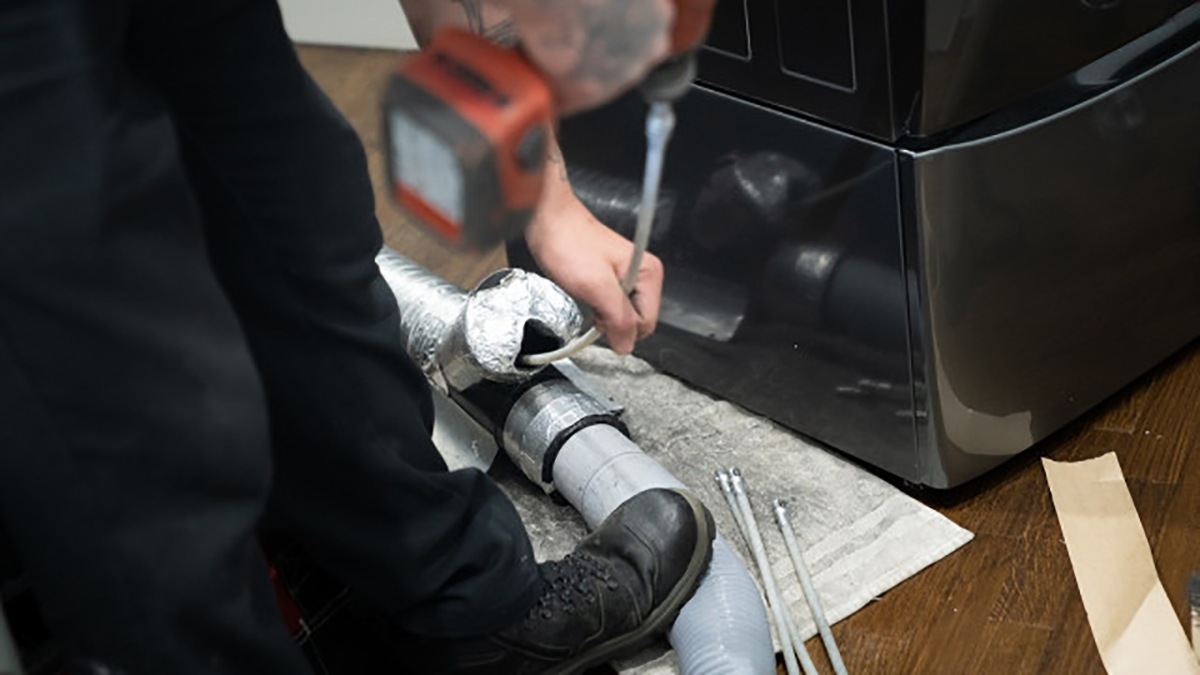Your spring-cleaning list is not complete until you’ve cleaned out your dryer exhaust vent.
You routinely clean out your dryer’s lint trap (after every cycle, right?), but unfortunately, that’s not enough. Each year, more than 2,900 clothes dryer fires lead to an average of 5 deaths, 100 injuries, and more than $35 million in property loss.
Many of these fires occur because excess lint ignites in the unit’s exhaust vent (the aluminum hose that stretches from the back of the dryer to the outside). This vent often collects dust and lint, which can also increase your gas and electricity costs as well as damage your dryer’s heating element.
That’s why we put together this quick guide to help you navigate dryer exhaust vent cleaning, help your clothes smell springtime fresh, and keep your home intact!
Dirty dryer vent warning signs

Because your dryer exhaust vent leads outside, you may find it difficult to know when it’s dirty. If you see one or more of these warning signs, you know it’s time for a cleaning:
- A longer drying time than usual
- Lint everywhere – on your clothes, around the doorway, behind your dyer
- An overheating dryer that shuts off regularly
- A moldy smell on your clothes and in your dryer
- Hotter than usual clothes or dryer at the end of a normal drying cycle
- A lack of lint or lint on the wrong side of the filter
- A burning smell in the laundry room
- Pet hair on clothing after a drying cycle (if you have a pet)
If you notice any of these signs, call a professional dryer vent cleaning service to address the issue.
When to add this task to your home maintenance checklist
Many experts suggest having your dryer vent cleaned at least once a year, but depending on how often you use your dryer, you may need to clean it more often. The National Fire Protection Association’s Desk Reference recommends cleaning your exhaust vent up to four times a year – or once a season.
Annual dryer exhaust vent cleaning cost

According to HomeAdvisor, a typical dryer cleaning costs between $101 – $176. A high-end job can run as much as $300, but that’s generally if your dryer is located far from an exterior wall or you have a rooftop vent.
Avoid DIY dryer vent cleaning

While you may see dryer vent cleaning kits and brushes in your local home improvement store, appliance maintenance should always be left to professionals. This is especially important for gas dryers as natural gas is highly flammable.
A professional dryer cleaning service can help keep you healthy in a few different of ways. Rodents and birds frequently make nests in vents, and their droppings can contain harmful bacteria. A professional will be able to remove any nests and sanitize the lines. Also, a professional can make sure your appliance works properly after the cleaning, which is important to prevent a buildup of dangerous carbon monoxide. Safety first!
Stop lint in the first place

While you’ll need to have a professional periodically clean out your dryer exhaust vent, you’ll also want to stop lint buildup in the first place. This will not only make the cleanup job easier, but it’ll also up the appliance’s efficiency, keep your utility bills low, and prolong the life of your unit.
Complete the following clothes dryer maintenance tasks regularly:
- Remove all items – wrappers, receipts, money – from pockets before washing and drying clothes
- Clean your lint trap after every cycle
- Sweep the area around your dryer
- Remove the lint trap and vacuum around the area on a weekly or monthly basis (depending upon how often you use your dryer)
- Give your lint tray a deep cleaning with hot water, dish soap, and a sponge (allow tray to air dry before returning it)
Homeowner Insurance for The Way You Live
At Franklin Mutual Insurance, we recognize your home is more than an investment and place to live. It’s a safe haven where friends and family gather, memories are made, and your most valued possessions reside. Give your home and loved ones the protection they deserve with extensive property and liability coverage that can be customized to meet your needs and budget.
Learn more about our homeowners insurance policies now.
FMI content is powered by vipHomeLink